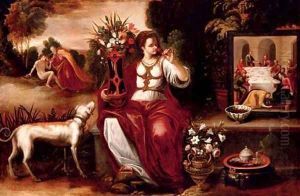Juan De Arellano Santorcaz Paintings
Juan de Arellano was a prominent Spanish painter of the Baroque period, renowned primarily for his exquisite flower pieces that have captivated art lovers for centuries. Born in Santorcaz, near Madrid, Spain, in 1614, Arellano grew up in an era that valued the arts highly, with the Spanish court and its nobility being avid patrons. Despite the prominence of religious and historical themes in Spanish Baroque art, Arellano carved a niche for himself by focusing on floral still lifes, a genre that was gaining popularity across Europe for its beauty and symbolic content.
Arellano’s journey into the arts began under the tutelage of Juan de Solís, a painter whose influence is evident in Arellano's early works. However, it was his exposure to the works of Flemish and Italian masters, either through direct study or copies circulating in Spain, that truly shaped his stylistic development. By the mid-17th century, Arellano had established himself as a master of the flower still life, blending realism with a vibrant palette that brought his compositions to life. His works often featured an array of flowers in elaborately detailed vases, set against dark backgrounds that enhanced the luminosity and color of the floral arrangements.
Throughout his career, Arellano's paintings reflected not only his technical skill but also the symbolic interpretations of flowers that were prevalent at the time. Flowers in his paintings were not just decorative elements; they carried meanings of vanity, the brevity of life, and the beauty of creation, echoing the vanitas themes common in Baroque art. Despite his focus on still lifes, Arellano did not completely shy away from religious themes, although these works were less frequent and are less remembered today.
Juan de Arellano's legacy is that of a pioneer in the still life genre in Spain, inspiring subsequent generations of Spanish artists. His ability to infuse life into inanimate objects, combined with his meticulous attention to detail and color, has ensured his place in the annals of art history. Arellano passed away in Madrid in 1676, leaving behind a body of work that continues to be admired for its beauty and technical proficiency. His paintings are now housed in many of the world's leading museums, testament to his enduring appeal and the universal language of art that he so masterfully spoke.
